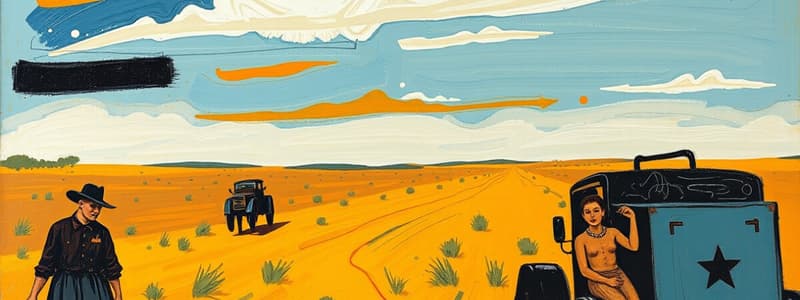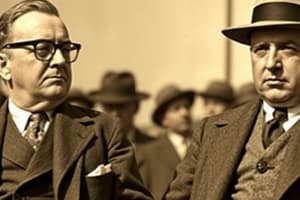Podcast
Questions and Answers
The ________ ______, 1890, was also known as the Tariff Act of 1890.
The ________ ______, 1890, was also known as the Tariff Act of 1890.
McKinley Tariff
The ____ ____ was a nickname for the Great Plains regions hit by drought and dust storms.
The ____ ____ was a nickname for the Great Plains regions hit by drought and dust storms.
Dust Bowl
The _____ ______ _____ of 1929 was a significant event that accelerated the global economic collapse.
The _____ ______ _____ of 1929 was a significant event that accelerated the global economic collapse.
Stock Market Crash
Buying on ______ means paying a small percentage of a stock's price as a down payment.
Buying on ______ means paying a small percentage of a stock's price as a down payment.
The _____ ____ were WWI veterans who marched on Washington demanding their $1,000 bonus pay.
The _____ ____ were WWI veterans who marched on Washington demanding their $1,000 bonus pay.
___________ were depression shantytowns named after the president blamed for their financial distress.
___________ were depression shantytowns named after the president blamed for their financial distress.
The _- ___ established the highest protective tariff in United States history.
The _- ___ established the highest protective tariff in United States history.
_______ ___ _____ is the phrase known for when FDR sought to add more justices to the Supreme Court.
_______ ___ _____ is the phrase known for when FDR sought to add more justices to the Supreme Court.
The _______ _______ _________ ___________ is the agency that insures customer deposits if a bank fails.
The _______ _______ _________ ___________ is the agency that insures customer deposits if a bank fails.
_______ _______ was the first woman appointed into the US Cabinet by President Roosevelt.
_______ _______ was the first woman appointed into the US Cabinet by President Roosevelt.
Flashcards are hidden until you start studying
Study Notes
Economic and Political Context of the 1930s
- The McKinley Tariff (1890) raised average duties on foreign imports to nearly 50%, reflecting Republican support for high tariffs.
- The Stock Market Crash of 1929 significantly contributed to the Great Depression, with bank failures reaching nearly 50% by 1933 and unemployment soaring to 30% of the workforce.
Environmental and Social Impact
- The Dust Bowl refers to severe droughts and dust storms in the Great Plains, where over-farming led to soil erosion and creation of "black blizzards."
- Hoovervilles were makeshift shantytowns where homeless people lived during the Great Depression, named in derision against President Hoover.
Legislative Measures and Government Actions
- The Hawley-Smoot Act established the highest protective tariff in U.S. history, primarily aimed at protecting American agriculture and industry from foreign competition.
- The Federal Deposit Insurance Corporation (FDIC) was created to insure bank deposits, providing stability to the banking system.
Notable Figures and Events
- The Bonus Army comprised WWI veterans demanding early payment of their bonuses, reflecting widespread dissatisfaction with the government during the Depression.
- FDR's proposal to "pack the court" aimed to increase the number of Supreme Court justices, attempting to sway decisions in favor of his New Deal policies.
- Frances Perkins made history as the first woman appointed to the U.S. Cabinet, serving under FDR and advocating for labor rights and social welfare reforms.
Studying That Suits You
Use AI to generate personalized quizzes and flashcards to suit your learning preferences.




